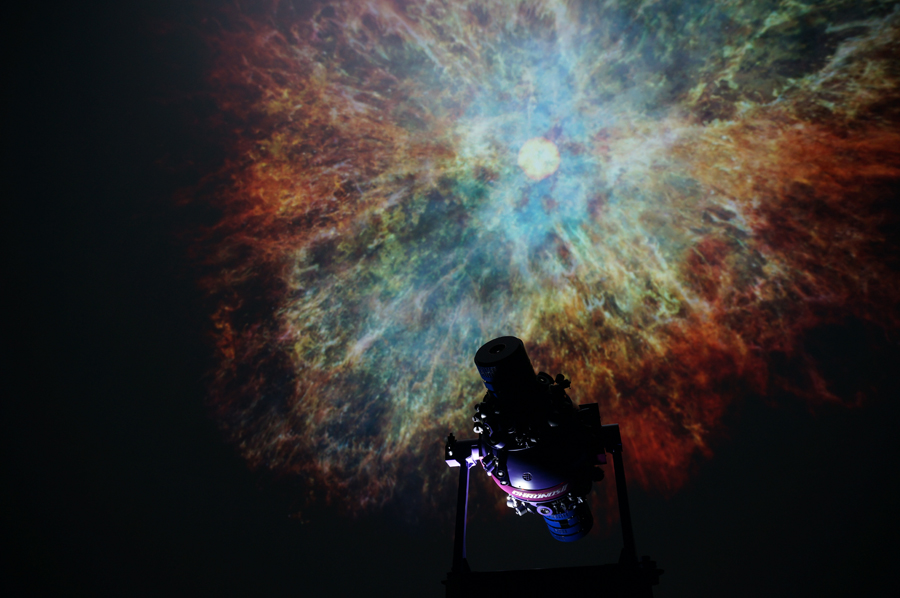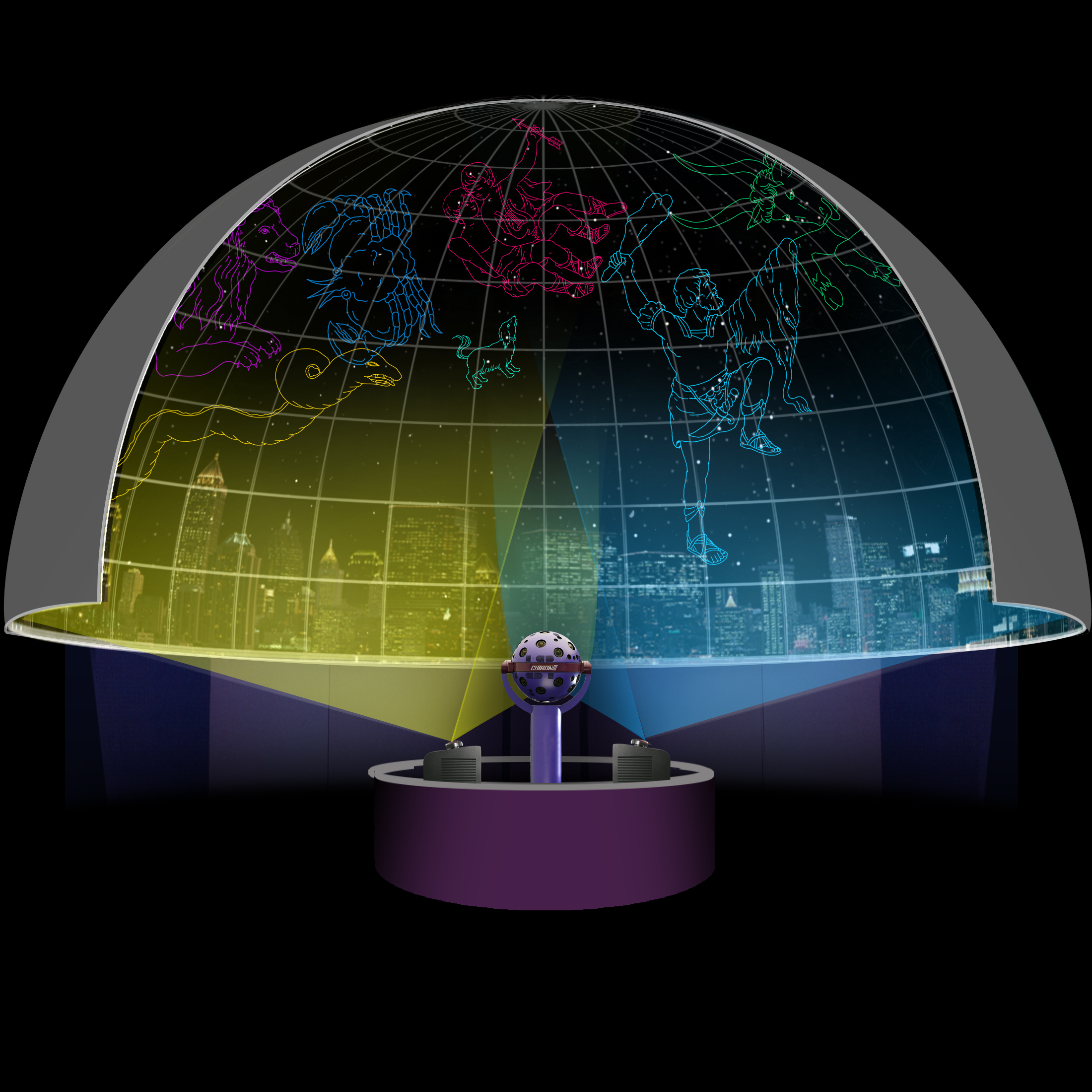What are the components of a planetarium theater?
A planetarium theater basically consists of the six components described on this page. The success of the theater greatly depends upon how well the components work together as a whole. Creating a quality theater for quality programming requires careful consideration during the design stage.
GOTO has over 50 years of experience in designing theaters and manufacturing planetarium equipment, so please consult with us when you plan the construction of a planetarium.
Dome Screen
In a planetarium, the stars and other scenes are projected onto the surface of a dome screen which is a full or partial hemisphere. Permanent domes are carefully-formed aluminum sheets with millions of small holes. The holes allow sound and air to flow unimpeded to the audience. The reflectivity of the paint on the sheets is carefully matched with the projectors to be used in it.
A framework of ribs supports the perforated sheets to a high degree of accuracy, maintaining a near-perfect “seamless” dome. Ladders or catwalks are often included behind the dome surface for cleaning purposes, and to maintain the loudspeakers located there. The audience experience depends greatly upon the quality of the dome screen, so special attention must be paid to its design and construction. GOTO INC works with several carefully chosen dome vendors around the world. This helps to ensure that the highest standards of dome screens are provided in your planetarium.
What kind of dome screen are there?
a. Horizontal Dome

Sapporo Science Center
standard proposal
Center Dual Mounted

Alternative proposal
6 Cove Mounted

a. Horizontal Dome Planetarium Theater
Unmatched Realism – The Night Sky
Planetarium theaters can be divided into two types; the horizontal dome type, when the dome edge is parallel to the ground, and the tilted dome type, where the floor and dome are inclined at an angle. While horizontal domes may or may not have sloped floors, the horizontal dome shows the realistic environment of the outdoors. For schools and educational institutions, astronomy education focuses on the movement of the heavenly bodies as viewed from earth. For introducing the concept of a celestial sphere, and for teaching constellations or navigation, the horizontal dome is best because it simulates the sky as seen by everyday observers.
Synchronizing fulldome video in HYBRID systems adds elements such as local star lore, Greek mythology, and space exploration. From serious learning to entertainment, the horizontal planetarium dome fills a wide variety of purposes.
Compared to a tilted dome, horizontal domes cost less to construct, have a greater seating capacity, reduce the number of trip and fall accidents, and offer easy accessibility to audience members
with limited personal mobility while avoiding the added costs of elevator lifts.
b. Tilted Dome

Yokkaichi Municipal Museum・Planetarium
Standard proposal
Center Dual Mounted

Alternative proposal
6 Cove Mounted

b. Tilted Dome Planetarium Theater
Experience the sensation of floating in outer space
The tilted dome reproduces the motions of the stars as seen from space, as well as from the Earth.
Fulldome video such as GOTO VIRTUARIUM X can enhance the feeling of flying through the Universe.
Larger diameter tilted domes can also function as a lecture or performance hall.
Compared to the horizontal dome, the tilted type accommodates fewer seats, but the overall presentation is dramatically immersive. Locating the entrance and exit on different levels provides efficient movement of visitors through the theater. This feature is a distinct advantage of the tilted dome design and is widely used in science centers where access and audience flow from one exhibit venue to the next is critical.
Seating

The audience in a planetarium must see the whole dome overhead, whether in tilted or flat dome configurations. This means that the seats should be at least somewhat reclining and have a headrest to avoid neck strain. The front rows recline at a greater angle than the back rows.
Seat backs can range from a tilt of 20º-45º, depending upon placement in the dome and dome tilt. Seats may have either fixed backs or adjustable angle seats.
A wide array of seating options are available from many companies. Swing-arm writing desks, folding armrests, companion seating, and even removeable seats allow users to customize their seating plan. Each configuration has its benefits and drawbacks, so it is best to consult with GOTO to find a seat type that best fits your intended audiences.
Naturally, all seat layouts must comply with local fire codes and handicapped accessibility standards. While in the past planners often crowded in as many seats as possible, today planners are considering comfort and ease of entry/exit as high priorities items as well. GOTO is happy to advise you on the type and layout of seating.
Theater Lighting

The dark, immersive environment of the dome theater an ideal showplace for dramatic lighting. While bright work lights are necessary for cleaning and maintenance, very subtle aisle and step lighting is necessary for safety during programs. GOTO experts can work with your architects and electrical engineers to ensure that the dark environment is preserved when needed, yet safety lights will pop on during any emergency.
Cove-mounted lights can bathe the theater in intense colors. Planetariums were an early-adopter of controllable LED lighting, and continue to push the lighting envelope. Red, green, and blue LEDs are mixed to produce thousands of vivid colors, and animated switching of sections of cove lights can create anything from a sunset on Mars to a lightning storm over city suburbs.
The Opto-Mechanical Projector

Often called the planetarium projector, star machine, or starball, this projector sits at the precise center of the dome. This machine creates the stars with such resolution, clarity, color, and brightness that no other type of projector can begin to match. With some types of starballs, sun moon and planet projectors may be mounted in front of the main projector. And a control console is generally placed at the back of the theater. Electronics racks with support equipment are mounted in a nearby equipment room. GOTO produces these opto-mechanical marvels to be the very heart of every planetarium.
Planet Projectors

Sun, moon, and planet projectors are a special passion at GOTO. Whether they are the smooth-motion, rapid, and accurate free-standing projectors of the CHIRON and PANDIA line, or projectors mounted on the main body of the CHRONOS, these projectors create sharply focused, brilliant solar system images which no video projector can begin to match. When Venus rises in a GOTO planetarium, there is no need to put a label on it to tell it from a star – because as under the real sky, the audience will demand to know, “What’s that bright thing?”
Fulldome Video

In 1996, GOTO produced the world’s first system of video projectors driven by multiple image-generating computers which filled the sky with huge, seamless scenes. These fulldome systems rapidly replaced the dozens or hundreds of special effects projectors previously used in large planetariums. In recent years, fulldome video systems have taken on an important role in planetariums. When the motions of colorful video images shown from the fulldome system are synchronized with the motions of precise images shown by the opto-mechanical projector, the spectacular and ultimately flexible GOTO HYBRID Planetarium® is born.
HYBRID System

FOR EXAMPLE : HYBRID PLANETARIUM / CENTER DUAL VIDEO PROJECTOR
HYBRID planetariums can show not only rich astronomical programming, but can also range farther into programming in subjects such as geology, meteorology, biology, oceanography, and more. Together, the two parts of the HYBRID system can take audiences anywhere in the Universe, to examine phenomena on a scale of microscopic to infinite. The Universe is your playground with a HYBRID planetarium.
HYBRID Console

Our hybrid console is the ergonomically designed manual control console and automation control and hardware and software which ties the two primary projection systems together in an efficient, innovative, synchronized whole.
The system must be easily operated in manual/live program mode by an operator with little or no previous classical planetarium experience, but with only 8 hours of additional training on the new system.
Audio System

Audio mixer
Sound adds a vital dimension to a planetarium in the form of music, narration, and sound effects. Audio systems range from the very simple to super high quality multi-channel systems rivaling those in state of the art live theaters or cinemas. GOTO can help guide you to the audio system that is appropriate for your needs, and which fits your budget.
Others
In addition to the above components, light-blocking entries, air conditioning, smoke detectors, fire sprinklers, etc. must all be taken into account in the overall design.




